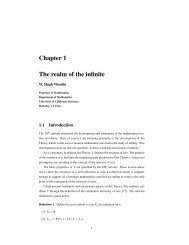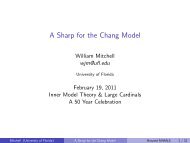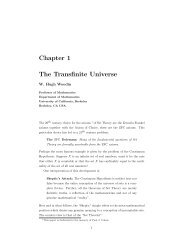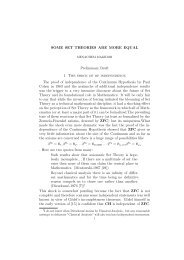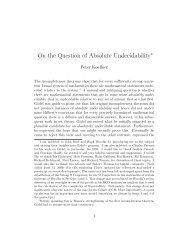The Continuum Hypothesis - Logic at Harvard
The Continuum Hypothesis - Logic at Harvard
The Continuum Hypothesis - Logic at Harvard
You also want an ePaper? Increase the reach of your titles
YUMPU automatically turns print PDFs into web optimized ePapers that Google loves.
So, of the various theories T A involved in <strong>The</strong>orem 5.1, there is one th<strong>at</strong>stands out: <strong>The</strong> theory T (∗) given by (∗). This theory maximizes the Π 2 -theory of the structure 〈H(ω 2 ),∈,I NS ,A | A ∈ P(R) ∩ L(R)〉. <strong>The</strong> fundamentalresult is th<strong>at</strong> in this maximal theory2 ℵ 0= ℵ 2 .5.2 <strong>The</strong> Parallel Case for CH<strong>The</strong>parallelcaseforCHalsohastwosteps, thefirstinvolving Ω-completenessand the second involving maximality.<strong>The</strong> first result in the first step is the following:<strong>The</strong>orem 5.4 (Woodin, 1985). Assume ZFC and th<strong>at</strong> there is a proper classof measurable Woodin cardinals. <strong>The</strong>n ZFC+CH is Ω-complete for Σ 2 1 .Moreover, up to Ω-equivalence, CH is the unique Σ 2 1-st<strong>at</strong>ement th<strong>at</strong> is Ω-complete for Σ 2 1 ; th<strong>at</strong> is, letting T A be the Ω-complete theory given by ZFC+A where A is Σ 2 1 , all such T A are Ω-equivalent to T CH and hence (trivially)all such T A contain CH. In other words, there is a “good” theory and all“good” theories imply CH.To complete the first step we have to determine whether this result isrobust. For it could be the case th<strong>at</strong> when one considers the next level,Σ 2 2 (or further levels, like third-order arithmetic) CH is no longer part ofthe picture, th<strong>at</strong> is, perhaps large cardinals imply th<strong>at</strong> there is an axiom Asuch th<strong>at</strong> ZFC+A is Ω-complete for Σ 2 2 (or, going further, all of third orderarithmetic) and yet not all such A have an associ<strong>at</strong>ed T A which contains CH.We must rule this out if we are to secure the first step.<strong>The</strong> most optimistic scenario along these lines is this: <strong>The</strong> scenario isth<strong>at</strong> there is a large cardinal axiom L and axioms A ⃗ such th<strong>at</strong> ZFC+L+⃗A is Ω-complete for all of third-order arithmetic and all such theories areΩ-equivalent and imply CH. Going further, perhaps for each specifiablefragment V λ of the universe of sets there is a large cardinal axiom L andaxioms A ⃗ such th<strong>at</strong> ZFC+L+ A ⃗ is Ω-complete for the entire theory of V λand, moreover, th<strong>at</strong> such theories are Ω-equivalent and imply CH. Werethis to be the case it would mean th<strong>at</strong> for each such λ there is a unique Ω-completepictureofV λ andwewouldhaveauniqueΩ-completeunderstandingof arbitrarily large fragments of the universe of sets. This would make for a29





